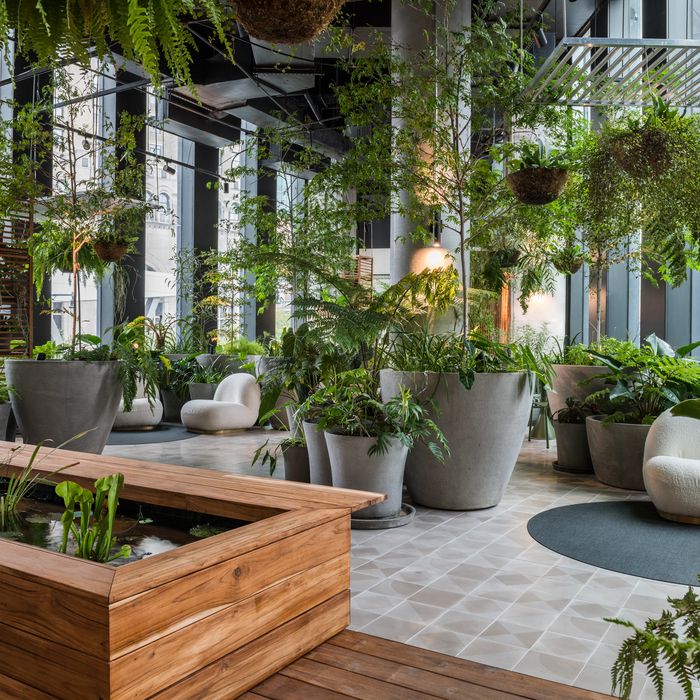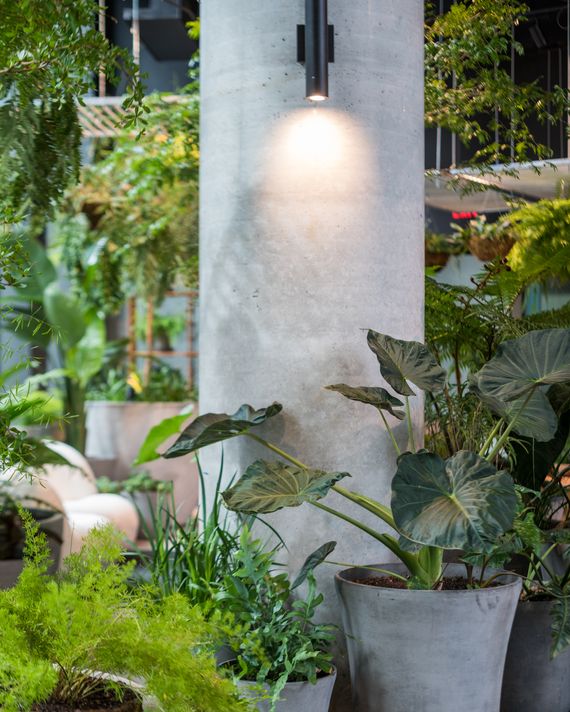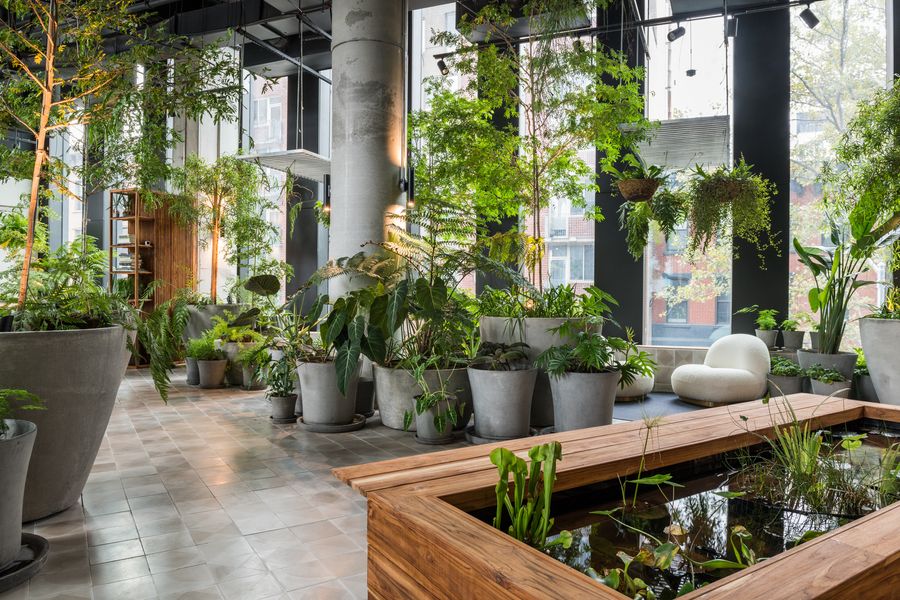
The first all-electric skyscraper in New York City, an angular tower of glass and cast concrete at 505 State Street, is tech-forward, obviously. The building’s 440 rental units feature minimalist induction cooktops and Wi-Fi-enabled Ecobee smart thermostats that learn your schedule and adjust themselves accordingly. There are sprawling, shared workspaces with Zoom rooms you can reserve on your phone. But an airy, sunlit room on the second floor is decidedly Luddite. Filled with ferns, orchids, and potted trees, a sign next to the door explains the concept: No phones allowed. “We wanted to give people space to unplug, emotionally and mentally,” says AJ Pires, the president of Alloy, the project’s developer.
The Grow Room, as it’s called, is home to 500 plants, including Woodwardia chain ferns, powderpuff trees from southern Florida with Seussian pink fluff balls, and a peat bog with lotuses and teacup alocasia floating in muddy-looking water. There’s nice light, a gentle breeze from the fans continually circulating air, and Goop-esque white bouclé chairs. After years of luxury buildings boasting about Wi-Fi and connectivity, Peloton-filled gyms, and app-based concierge services, turning some version of mental quiet into a luxury amenity is a little audacious. It’s also an almost inevitable evolution of two increasingly popular, interrelated trends meant to quiet the anxiety of our smartphone-addled age: tech-free spaces and biophilic design, which has found some of its most enthusiastic practitioners among the tech firms orchestrating our increasingly optimized lives. It calls to mind Adam Neumann’s preference to go barefoot: The tranquility seekers enjoying the Grow Room will mostly be the sort who can pay $4,700 a month to live in a one-bedroom (save for the tenants of the 45 affordable units in the building).
While throwing up a green wall in the lobby was considered impressive in the mid-aughts, now companies are hiring firms to design elaborate plantscapes that rival Victorian-era conservatories, with hanging planters, water features, and meditative nooks. “It’s a whimsical space for people to engage with things outside of technology,” says Abby Lee of Outlands Botanics, who designed the space in collaboration with Meaghan Lynch and Rachel Johnston of Studio Prospect, an architecture and landscaping firm, and Walk and Talk Consulting, a design-build firm that also worked on Russ & Daughters Cafe and Lilia. “People who visit the building might not have a nature experience every day, but it can be a nice reminder,” says Lynch. So far, they’ve noticed people having quiet conversations among the ferns, reading, or staring into space.
“Biophilia is certainly booming,” says Rebecca Bullene, the founder of Greenery NYC, a horticulture-design firm that has worked on offices for Hinge, Etsy, and the New York Times. “Fifteen years ago, it was someone wanting to have a few potted plants in a conference room. Now, companies want to give employees access to a good plant program, make them feel less stressed, more productive.” Google’s new Chelsea headquarters, for example, is landscaped with 1.5 acres of mostly native plants designed to attract pollinators. Amazon, a company known for its stinginess compared to other tech giants, built the Sphere project — essentially an indoor rainforest — at its Seattle headquarters, a three-building conservatory with 40,000 plants from cloud forest regions. Also, she adds, the technologies have vastly improved: Automated irrigation systems and grow lights now allow for far more ambitious projects in many different types of spaces.
The Grow Room is in some ways a miniature of the already popular detox retreat. Disconnection is no longer just a matter of leaving your phone behind while you run errands; it must be a mindful, and now monetizable, practice. (Partially out of social convention — informing people when you silence your notifications is now considered basic etiquette — and partially out of necessity, because how else can you force yourself not to obsessively check your phone?) Miraval Resorts & Spas, an upscale intentionally tech-free resort with locations in Austin, Arizona, and the Berkshires, started a digital mindfulness program in 2018, providing guests with cell-phone sleeping bags for their rooms and maps of the places where phones are allowed — mostly high-traffic areas, like the lobby. “Looking ahead, the desire for digital-free environments will only continue to grow as more people seek spaces that are intentionally designed to foster wellbeing, presence, and meaningful reconnection,” the company wrote in an email.
And now they can do that, in tidy increments between Zoom meetings, in the Grow Room. “Now people do 15 minutes over lunch and they call it a digital detox,” says Trine Syvertsen, a professor at the University of Oslo who wrote the 2020 book Digital Detox: The Politics of Disconnecting. Tech backlashes are nothing new, Syvertsen adds — TV cabinets were a kind of proto phone sleeping bag — but the way we deal with digital addiction is different than in the past. “It’s very individualized — there’s this inward shame, the duty to balance it,” she says. And there is of course a grab bag of methods available to do that: productivity apps that limit screen time or silence notifications, and, for those who can afford them, physical ones, like tech-free schools, retreats, and spaces like the Grow Room.
The triple-paned windows on one side of 505 State’s Grow Room overlook the Apple store on Flatbush Avenue, the nearby intersection of Atlantic a near-constant traffic jam. It’s a choice that Pires, the developer, says was intentional. “A counterpoint to all the distraction and chaos.” The Grow Room, by contrast, is serene, just the sound of the peat-bog fountain and the ferns gently swaying in the fans. Being online all the time, once a mark of affluence, is increasingly its opposite. As Syvertsen put it: “Offline is the new luxury.”




